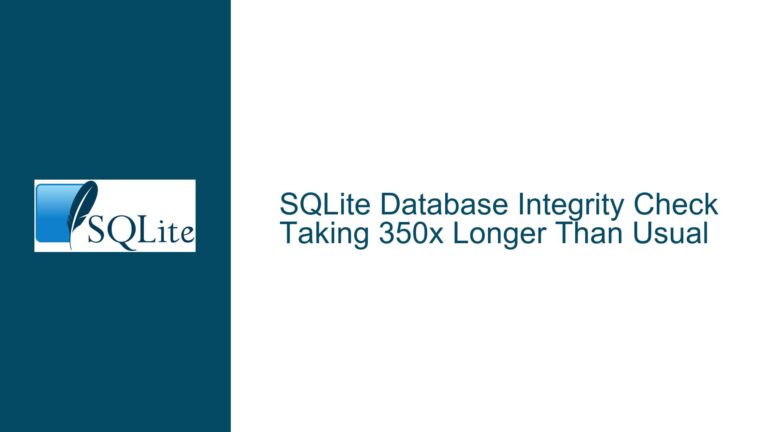Optimizing SQLite GROUP BY Queries with Indexes: Why Indexes Are Ignored and How to Fix It
Understanding Why SQLite Chooses the Wrong Index for GROUP BY Queries
When working with SQLite, one of the most common performance bottlenecks arises from the misuse or underutilization of indexes, particularly in queries involving GROUP BY clauses. The core issue in this scenario is that SQLite’s query planner sometimes selects an index that appears suboptimal for the query, leading to slower performance. This behavior is often misunderstood, as developers expect the database to automatically choose the most efficient index. However, the query planner’s decision is influenced by several factors, including the structure of the index, the distribution of data, and the specific conditions in the query.
In the provided example, the table orders has two indexes: wrong_index on (client, time) and good_index on (time, client). The query in question is:
SELECT count(*) FROM orders WHERE time > 10 GROUP BY client;
Despite the presence of good_index, SQLite chooses to use wrong_index, which results in a full table scan (SCAN orders USING COVERING INDEX wrong_index). This behavior is counterintuitive, as one would expect good_index to be more efficient due to its alignment with the WHERE clause (time > 10). To understand why this happens, we need to delve into how SQLite’s query planner evaluates indexes and makes decisions.
The Role of Index Order and Data Distribution in Query Planning
The primary reason SQLite chooses wrong_index over good_index lies in the way indexes are structured and how they align with the query’s requirements. Indexes in SQLite are ordered data structures that allow for efficient lookups based on the columns they include. However, the order of columns in an index significantly impacts its usability for specific queries.
In the case of wrong_index, the index is ordered first by client and then by time. This ordering is beneficial for queries that filter or group by client, as rows with the same client value are stored contiguously. However, for the query SELECT count(*) FROM orders WHERE time > 10 GROUP BY client, the GROUP BY clause requires rows to be grouped by client, but the WHERE clause filters based on time. Since wrong_index groups rows by client first, it can efficiently satisfy the GROUP BY requirement but struggles with the time > 10 filter, as time values are scattered across different client groups.
On the other hand, good_index is ordered first by time and then by client. This ordering is ideal for filtering rows based on time, as rows with time > 10 are stored contiguously. However, it is less efficient for grouping by client, as rows with the same client value are not stored together. As a result, SQLite’s query planner determines that using wrong_index is more efficient for the GROUP BY operation, even though it requires scanning a larger portion of the index to apply the time > 10 filter.
Another critical factor influencing the query planner’s decision is the distribution of data in the table. If the client column has low cardinality (few distinct values), SQLite may determine that scanning the entire index to apply the time > 10 filter is more efficient than using good_index and then sorting the results for the GROUP BY operation. This decision is based on the assumption that the cost of sorting the filtered results outweighs the cost of scanning the index.
Leveraging ANALYZE and Query Hints to Optimize Index Usage
To address the issue of SQLite choosing the wrong index, we can employ several strategies, including running the ANALYZE command and using query hints. The ANALYZE command collects statistics about the distribution of data in the table and its indexes, which helps the query planner make more informed decisions. In the provided example, running ANALYZE changed the query plan from a full table scan (SCAN) to an index search (SEARCH), resulting in significantly faster query execution.
The ANALYZE command works by gathering information about the number of distinct values in each column, the distribution of values, and the correlation between columns. This information allows the query planner to estimate the selectivity of filters and the cost of different query plans more accurately. For instance, if ANALYZE reveals that the client column has low cardinality, the query planner may decide that scanning the index to apply the time > 10 filter is more efficient than using good_index and sorting the results.
Another approach to optimizing index usage is to use query hints, such as the unary plus operator (+), to influence the query planner’s decisions. In the example, adding a unary plus to the GROUP BY clause (GROUP BY +client) suppresses the use of any index for the GROUP BY operation. This forces the query planner to focus on optimizing the WHERE clause (time > 10), increasing the likelihood that good_index will be used. While this approach may not always yield the best results, it can be a useful tool for experimenting with different query plans and identifying the most efficient one.
In conclusion, understanding why SQLite chooses a particular index for a GROUP BY query requires a deep dive into the structure of indexes, the distribution of data, and the query planner’s decision-making process. By leveraging tools like ANALYZE and query hints, developers can optimize index usage and improve query performance. However, it is essential to approach optimization systematically, considering the specific characteristics of the data and the query, to achieve the best results.






